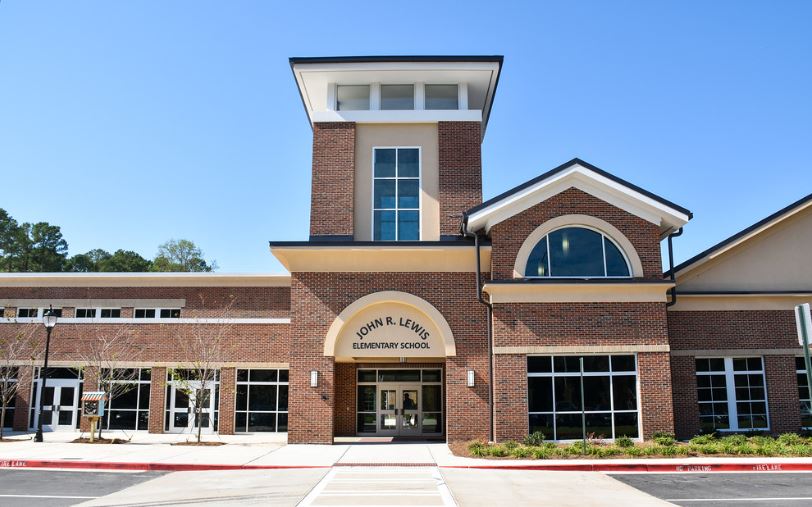Prototypes: Delivering equity and academic opportunity

Schools that use prototypes, such as the DeKalb County School District’s John R. Lewis Elementary School (pictured here), can stretch school district dollars while advancing educational equity.
Equity — it’s a word that holds different meanings in different contexts. In education circles, equity is defined as establishing resources and environments that ensure each school community member is provided fair, just and individualized learning and growth. School buildings set the stage for the educational environment and as a result, are integral parts of the equity equation.
With 53 percent of school districts across the United States reporting the need to replace or update multiple systems* and school construction budgets largely constrained, districts are working to find measures that advance equity across all communities regardless of socio-economic position.
School building prototypes — schools built using designs meant to be repeated at several sites — are increasingly important solutions in the effort to build and maintain equity. Here, we will explore how well-designed and well-constructed prototypes can serve as models for schools of the future, advancing equity and academic achievement across all communities.
Why are school buildings so important? Understanding the importance of the school building requires that we examine the impact architecture has on academic achievement. A growing body of research indicates that poorly designed, poorly maintained school buildings — which students from low income or marginalized families are more likely to attend — can have profoundly negative impacts on student health, behavior, engagement, academic achievement and growth across the K-12 spectrum. The focus on creating equity is becoming more mainstream with the recognition that poorly maintained buildings also adversely impact teachers and administrators, increasing turnover and contributing to reduced academic achievement.
Enter the prototype. Prototypes are a practical consideration, arising from the recognition of facilities’ impact on academic achievement and the limitations of funding. Prototypes can cut millions from capital costs and reduce maintenance and upkeep of HVAC systems, electrical systems and technology through economies of scale all while providing cost, quality and schedule assurance during the design and construction phases. The resulting cost savings enables districts to advance equity by delivering new prototype school buildings across the socio-economic scale that predominantly exists in large school districts.
Developing impactful prototypes. While prototypes hold great potential to provide facility equity, they cannot be designed in a vacuum. Developing and constructing successful prototypes requires significant expertise in planning, design and construction. Pre-planning efforts include examining district equity goals and including stakeholders such as parents, school mentors and community advocates as part of the program team. This provides insight into a school’s culture, challenges and strengths so that the team may develop prototypes that address specialized curriculum needs, meet design criteria and capture the district’s and stakeholders’ vision for optimal school buildings that blend into neighborhoods and adapt to fit varied sites.
We used these principles when we collaborated with leaders from the DeKalb County School District in Georgia, to manage the design and construction of their elementary prototype school buildings. The district’s Comprehensive Master Plan prioritized facility equity, diversity and inclusion, and focused on providing sustainable innovations and learning principles to promote academic opportunity. These include creating permanent student online learning options, developing a customized approach to learning, and strengthening Science, Technology, Engineering and Math (STEM) and Science, Technology, Engineering, the Arts and Mathematics (STEAM) programs.
Can prototypes meet specific community and student needs? Amid the positive aspects inherent in using prototypes, there are concerns that prototype school buildings might not reflect the communities in which they are situated. Program management expertise and experience can alleviate these issues. The prototype schools, which AECOM developed with the DeKalb school district, offer customizable finishes, enabling the community to convey the neighborhood’s culture and priorities and, importantly, are adaptable to specific area sites and cater to each school’s specialized curriculums. And because they are new buildings, the prototypes offer upgraded facilities and future-proof technologies often unavailable in the schools they replace, ensuring that all community schools have the facilities needed to enable learning.
As school districts seek to provide educational equity, prototypes offer a means to provide academic opportunity across district communities. These buildings, when thoughtfully designed and constructed, offer numerous advantages that can help districts stretch their resources and reach their goals for equity and academic advancement across socio-economic scales for their schools, now and in the future.
John Wright is the Program Principal for the DeKalb County School District’s Educational-Special Purpose Local Options Sales Tax (E-SPLOST) Capital Improvement Program.
*According to the American Society for Civil Engineers 2021 Report Card on Schools






